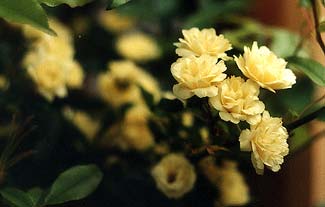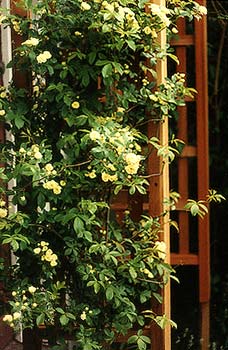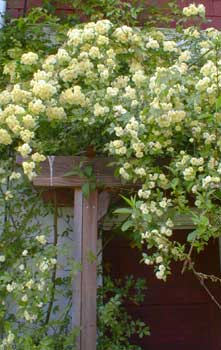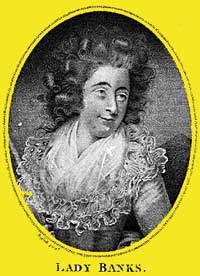 Lady Banks' Yellow Rose
Lady Banks' Yellow Rose
"The world is sadly sick, they say,
And plagued by woe & pain.
But look! How looms my garden gay,
With blooms in golden reign!"
-Robert William Service
(1874-1958)
(1874-1958)
 Rosa banksiae 'Lutea' or Lady Banks' Yellow Rose is a thornless rose which produces small round double-blossoms that look like pompoms. In our garden, in some years, the blossoms fill the branches in May & peter out in early June. In other years they are in full bloom in April, & petering out before the end of May.
Rosa banksiae 'Lutea' or Lady Banks' Yellow Rose is a thornless rose which produces small round double-blossoms that look like pompoms. In our garden, in some years, the blossoms fill the branches in May & peter out in early June. In other years they are in full bloom in April, & petering out before the end of May.We trained a Banks' Yellow to the arbor at the side-entry to the house. As this rose grows rampantly, by its fourth year it had reached roof; in its first year it only reached the top of the arbor. When we first planted it it was already gorgeous as a six-foot-tall upright shrub, almost free-standing even if it hadn't had the arbor.
 In warmer climates than Zone 8, it can be wildly aggressive & partially evergreen, but it is slightly more restrained & entirely deciduous on Puget Sound.
In warmer climates than Zone 8, it can be wildly aggressive & partially evergreen, but it is slightly more restrained & entirely deciduous on Puget Sound.But "more restrained" still means it'll climb 20 feet pretty easily & grow thicker each year if not regularly cut back. It requires a very sturdy structure when it is being trained to a trellis or arbor.
It is resistant to all the diseases to which fancy hybrid roses are subject. And except for pruning to restrict spread, it requires no care. We even avoid watering ours, the rain is more than sufficient.
This traditional thornless rose is unfortunately being displaced in peoples' hearts (& gardens) by the thousands of gigantic showy roses. Yet this species has been in cultivation since 1796, the yellow double arriving in English gardens only a little later.
That it is nearly unscented & does not rebloom after spring limits its appeal to the majority of modern rose fanciers. But as for myself, being no big rose fancier per se, I find most roses are just nasty blackberry vines with gaudy blooms affixed always making huge demands upon the gardener, who has to be a real fuss-budget to give them the amount of attention they require. By contrast, for my tastes, Lady Banks' Yellow Rose is maximumly appealing.
 The white single R. banksiae normalis is believed to be the original wild form. The white double form, R. banksiae banksia, was the first to be widely grown in English gardens. Liking the yellow so much, I briefly considered trying to find a place in the garden for a white Banks rose as well, but the white one does have thorns.
The white single R. banksiae normalis is believed to be the original wild form. The white double form, R. banksiae banksia, was the first to be widely grown in English gardens. Liking the yellow so much, I briefly considered trying to find a place in the garden for a white Banks rose as well, but the white one does have thorns. It was discovered by Sir Joseph Banks (1743-1820) who named it in honor of his bride. The engraving here at the right is of Sir Joseph. At the left, an engraving of Dorothea, Lady Banks, named for St. Dorothea, She of the Flower Basket.
It was discovered by Sir Joseph Banks (1743-1820) who named it in honor of his bride. The engraving here at the right is of Sir Joseph. At the left, an engraving of Dorothea, Lady Banks, named for St. Dorothea, She of the Flower Basket.That Banks roses can get big if permitted to go rampant is an understatement. I saw a photo of a yellow Banks that had heaped itself up over the whole roof of a mansion. Plus The Guinness Book of World Records identifies a specimen of the double-white Banks named "The Tombstone Rose" as the single largest rose in the whole world. Located near Tombstone, Arizona, it covers 8,000 square feet. This record-holder was planted in 1855 by a homesick bride.
The double-yellow has been gardened since at least 1824. It is best grown where its enthusiastic vigor need not be too restrained. It needs a lot of sun & not much watering, & is forgiving of most soil conditions other than dampness. It blooms on second & third year wood; whenever it is being pruned for size, the oldest dead wood should be cut foremost.
portrait of Lady Banks courtesy of
Deirdre Peters at Cofer's Home & Garden Showplace